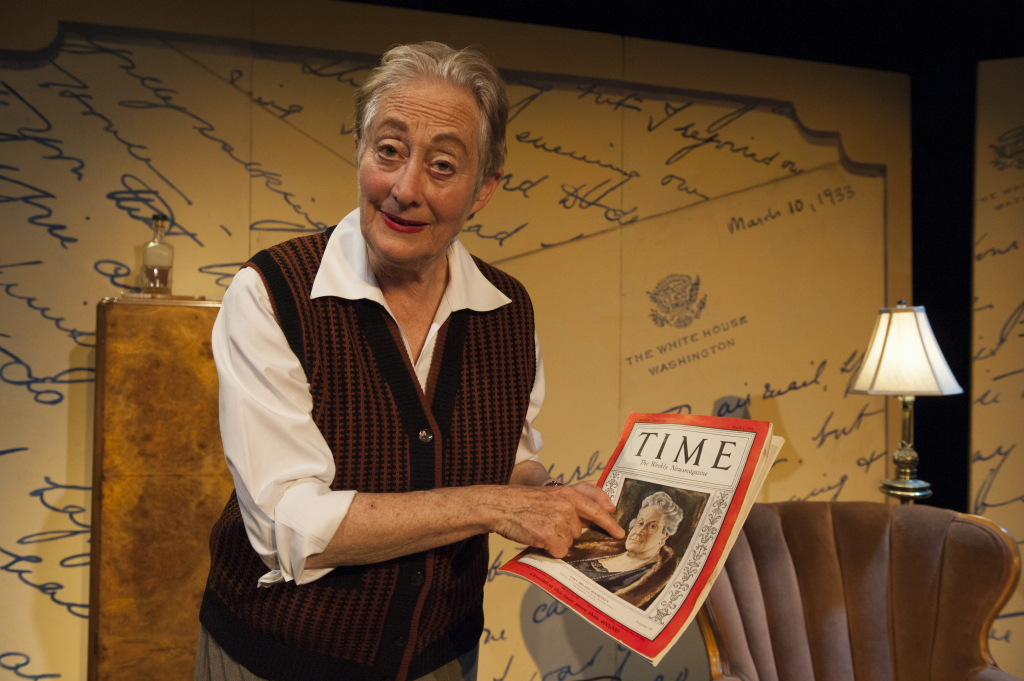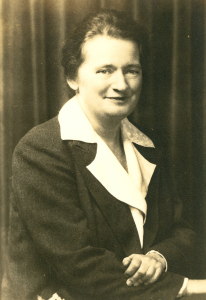
PLAYWRIGHT TERRY BAUM as Lorena Hickok in “HICK: A Love Story,” at the Berkeley City Club through Jan. 25. In 1933, Time Magazine referred to Hickok as “rumpled, fat, and masculine.”
Lynne Fried photo
Baum portrays Hickok and acts as the play’s narrator. She brings her character to life as a dedicated, talented and groundbreaking journalist (Hickock was reportedly the first woman to have a byline in the New York Times), a single woman starved for affection, and an enthusiastic advocate for women’s rights, all with an endearing warmth and vitality. Paula Barish is the voice of Eleanor Roosevelt, heard as Hickok reads the letters.
Special lighting effects (designed by Stephanie Anne Johnson) produce seamless scene changes throughout the performance in the tiny, rectangular stage space at the City Club. Darkness descends over Hickok as she walks away from her newsroom desk, for example, while light falls on the train car where she begins to interview Mrs. Roosevelt. For some of the more complex scene changes, the entire room is darkened for a few short moments.
The action in “Hick” centers on Roosevelt’s years in the White House, the political projects the two women worked on together, and their travels both together and apart. The story assumes what to many seems obvious after reading the collected letters — namely that the women’s relationship was primarily a romantic and sexual one. But the play also maintains a consistent air of propriety, never stooping to vulgar sexual references.
Some of the material, borrowed verbatim from the collected letters, is indisputably intimate: Hickok speaks of the touch of Eleanor’s hair, even the skin of her face against Hickok’s lips. What comes through most passionately, though, is the power of their emotional bond, apparent in the depth of affection they felt for each other, the degree to which they treasured their relationship and how strongly they missed each other when they were apart. “We are like two violin strings vibrating at the same frequency,” Hickok reads from one letter. Roosevelt often wrote to her daily, and they were known to have lengthy phone conversations.
The emphasis in “Hick” is certainly on the love shared between Eleanor and her journalist friend, but it also incorporates many of the significant events of her husband’s extended presidency and Hickok’s developing career. The play never bogs down with emotion but instead keeps a bright pace, artfully blending the compelling love story together with its historical background.“Hick” begins and ends with Hickok relaxing in her robe in 1968, reading from letters among the thousands Roosevelt had sent her up to the time of the First Lady’s death in 1962. They are stored roughly, in large cardboard boxes, but Hickok handles them with tenderness, ultimately pressing each to her heart. An archivist from the office of the FDR Library — which by the way was the first presidential library to be established in the United States — phones periodically, waiting for Hickok to agree to release the documents for historic preservation. The sense is that she is holding on to them more for her own pleasure — reliving the treasured years as she reads the letters over and over — than for the slight hesitancy she feels about revealing secrets that could have been scandalous during the First Lady’s lifetime.
Baum succeeds in presenting a detailed and heartfelt account of the special relationship these two women shared. It is a tender and informative piece, artfully crafted and beautifully executed. This one’s a winner.
If You Go
“HICK: A Love Story” continues at the Berkeley City Club, 2315 Durant St., Berkeley, through Jan. 25. Tickets are $20 except pay-what-you-can Thursdays. Call 800-838-3006 or visit www.crackpotcrones.com.
Elizabeth Warnimont is a freelance writer specializing in the performing arts. She is also a substitute teacher for the Benicia Unified School District.







Leave a Reply